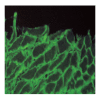A rare case of enteropathy-associated T-cell lymphoma presenting as acute renal failure
- PMID: 16610043
- PMCID: PMC4087668
- DOI: 10.3748/wjg.v12.i14.2301
A rare case of enteropathy-associated T-cell lymphoma presenting as acute renal failure
Abstract
Enteropathy-associated T-cell lymphoma (EATCL) is a high grade, pleomorphic peripheral T-cell lymphoma usually with cytotoxic phenotypes. We describe a first case of patient with EATCL that is remarkable for its fulminant course and invasion of both kidneys manifested as acute renal failure. The patient was a 23 year old woman with a long history of celiac disease. She was presented with acute renal failure and enlarged mononuclear infiltrated kidneys. Diagnosis of tubulointerstitial nephritis and polyserositis was confirmed with consecutive pulse doses of steroid therapy. After recovery, she had disseminated disease two months later. Magnetic resonance imaging showed thickened intestine wall, extremely augmented kidneys, enlarged intra-abdominal lymph nodes with extra-luminal compression of common bile duct. Laparotomy with mesenterial adipous tissue and lymph glands biopsy was done. Consecutive pathophysiological and immunohistochemical analyses confirmed the diagnosis of EATCL: CD45RO+, CD43+, CD3+. The revision of renal pathophysiology substantiated the diagnosis. The patient received chemotherapy, but unfortunately she died manifesting signs of pulmonary embolism caused by tumor cells.
Figures





Similar articles
-
[Enteropathy associated T-cell lymphoma].Srp Arh Celok Lek. 2007 Jan-Feb;135(1-2):80-4. doi: 10.2298/sarh0702080b. Srp Arh Celok Lek. 2007. PMID: 17503573 Serbian.
-
Peripheral T-cell lymphomas of the intestine.Am J Pathol. 1992 Dec;141(6):1361-71. Am J Pathol. 1992. PMID: 1466400 Free PMC article.
-
[A case of enteropathy-associated T-cell lymphoma presenting with recurrent hematochezia].Korean J Gastroenterol. 2003 Dec;42(6):527-32. Korean J Gastroenterol. 2003. PMID: 14695710 Korean.
-
Enteropathy associated T cell lymphoma.Cancer Surv. 1997;30:249-61. Cancer Surv. 1997. PMID: 9547996 Review.
-
Enterotherapy associated T-cell lymphoma: a case report and literature review.WMJ. 2000 Oct;99(7):28-31. WMJ. 2000. PMID: 11089447 Review.
Cited by
-
Preclinical studies in rats and squirrel monkeys for safety evaluation of the bivalent anti-human T cell immunotoxin, A-dmDT390-bisFv(UCHT1).Cancer Immunol Immunother. 2008 Aug;57(8):1225-39. doi: 10.1007/s00262-008-0457-x. Epub 2008 Feb 7. Cancer Immunol Immunother. 2008. PMID: 18256829 Free PMC article.
-
Serological and clinical comparison of children and adults with anti-endomysial antibodies.J Clin Immunol. 2007 Mar;27(2):163-71. doi: 10.1007/s10875-006-9062-y. Epub 2007 Jan 23. J Clin Immunol. 2007. PMID: 17243009
References
-
- de Bruin PC, Connolly CE, Oudejans JJ, Kummer JA, Jansen W, McCarthy CF, Meijer CJ. Enteropathy-associated T-cell lymphomas have a cytotoxic T-cell phenotype. Histopathology. 1997;31:313–317. - PubMed
-
- Sutcliffe SB, Gospodarowicz . Primary Extranodal lymphomas. In: The Lymphomas., editor. Canellos GP, Lister TA, Sklar JL. W.B. Philadelphia: Saunders Company; 1998. pp. 449–479.
-
- Harris NL, Jaffe ES, Diebold J, Flandrin G, Muller-Hermelink HK, Vardiman J. Lymphoma classification--from controversy to consensus: the R.E.A.L. and WHO Classification of lymphoid neoplasms. Ann Oncol. 2000;11 Suppl 1:3–10. - PubMed
-
- Harris NL, Jaffe ES, Diebold J, Flandrin G, Muller-Hermelink HK, Vardiman J, Lister TA, Bloomfield CD. World Health Organization classification of neoplastic diseases of the hematopoietic and lymphoid tissues: report of the Clinical Advisory Committee meeting-Airlie House, Virginia, November 1997. J Clin Oncol. 1999;17:3835–3849. - PubMed
Publication types
MeSH terms
LinkOut - more resources
Full Text Sources
Medical

